University Design It: Reflective Report on Design Thinking
VerifiedAdded on 2020/03/16
|14
|3975
|41
Report
AI Summary
This report is a reflective analysis of a Design It course, detailing the student's learning journey and experiences. It covers fundamental concepts like design thinking, brainstorming, and various methodologies used in design processes. The report discusses key topics such as design tools, blog creation, poster presentations, and assessment criteria. It explores design theories, including creative theory, decision-making, and team working. The student reflects on classroom activities, including problem-solving exercises, journey mapping, and value chain analysis. It delves into design research, prototyping, and the tools used in the design thinking process. The report concludes with a discussion of rapid prototyping, its benefits, drawbacks, and activities related to the design process, offering a comprehensive overview of the course content and the student's understanding of design principles.
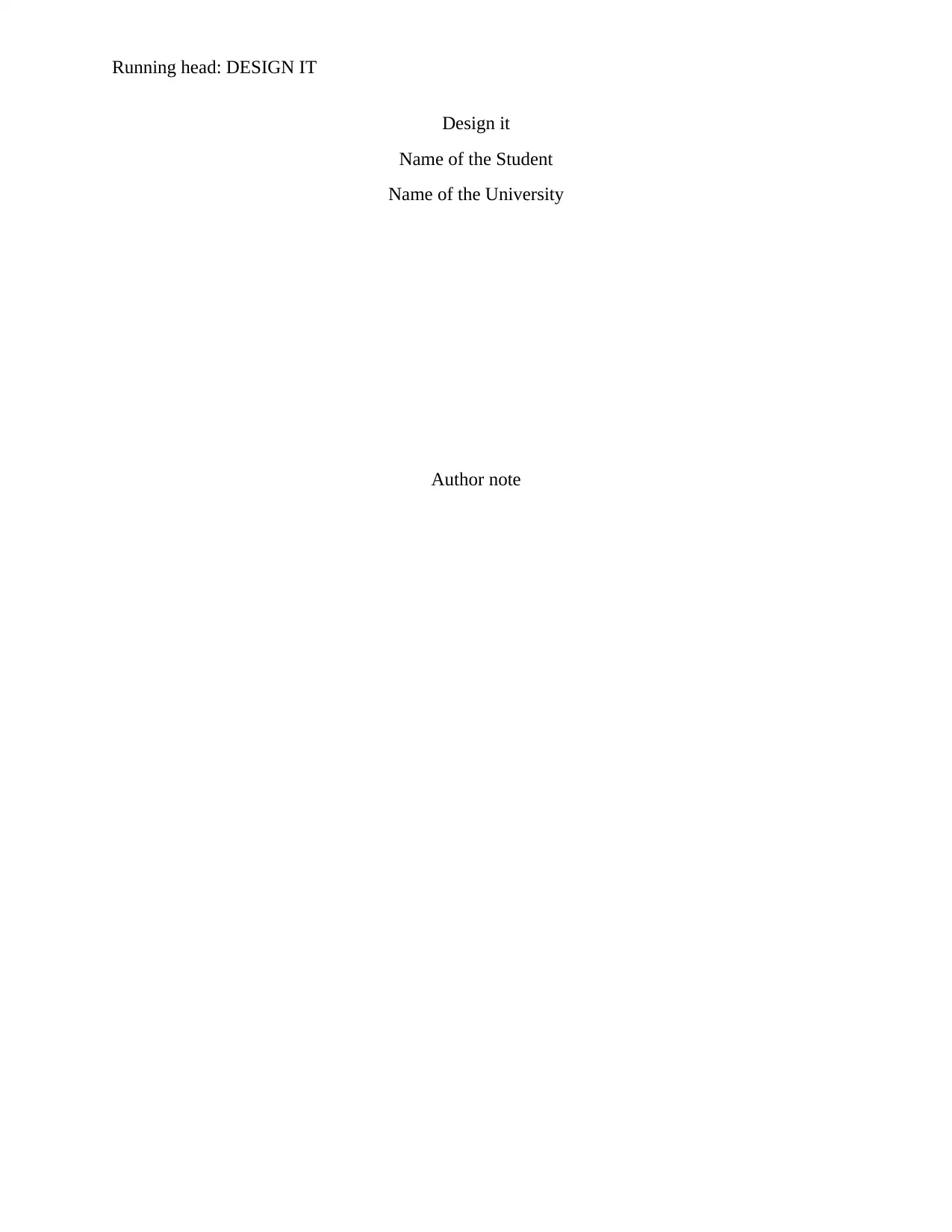
Running head: DESIGN IT
Design it
Name of the Student
Name of the University
Author note
Design it
Name of the Student
Name of the University
Author note
Paraphrase This Document
Need a fresh take? Get an instant paraphrase of this document with our AI Paraphraser
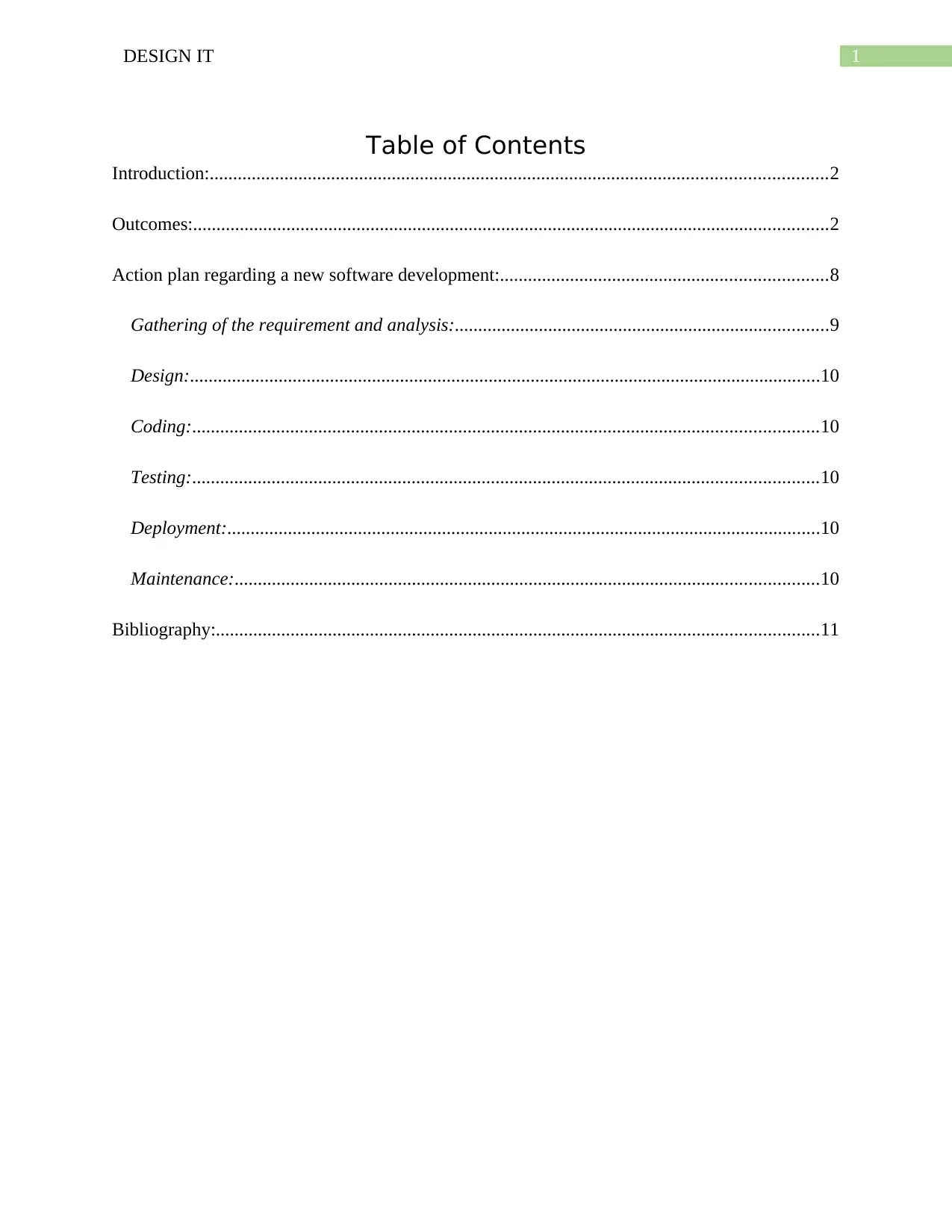
1DESIGN IT
Table of Contents
Introduction:....................................................................................................................................2
Outcomes:........................................................................................................................................2
Action plan regarding a new software development:......................................................................8
Gathering of the requirement and analysis:................................................................................9
Design:.......................................................................................................................................10
Coding:......................................................................................................................................10
Testing:......................................................................................................................................10
Deployment:...............................................................................................................................10
Maintenance:.............................................................................................................................10
Bibliography:.................................................................................................................................11
Table of Contents
Introduction:....................................................................................................................................2
Outcomes:........................................................................................................................................2
Action plan regarding a new software development:......................................................................8
Gathering of the requirement and analysis:................................................................................9
Design:.......................................................................................................................................10
Coding:......................................................................................................................................10
Testing:......................................................................................................................................10
Deployment:...............................................................................................................................10
Maintenance:.............................................................................................................................10
Bibliography:.................................................................................................................................11
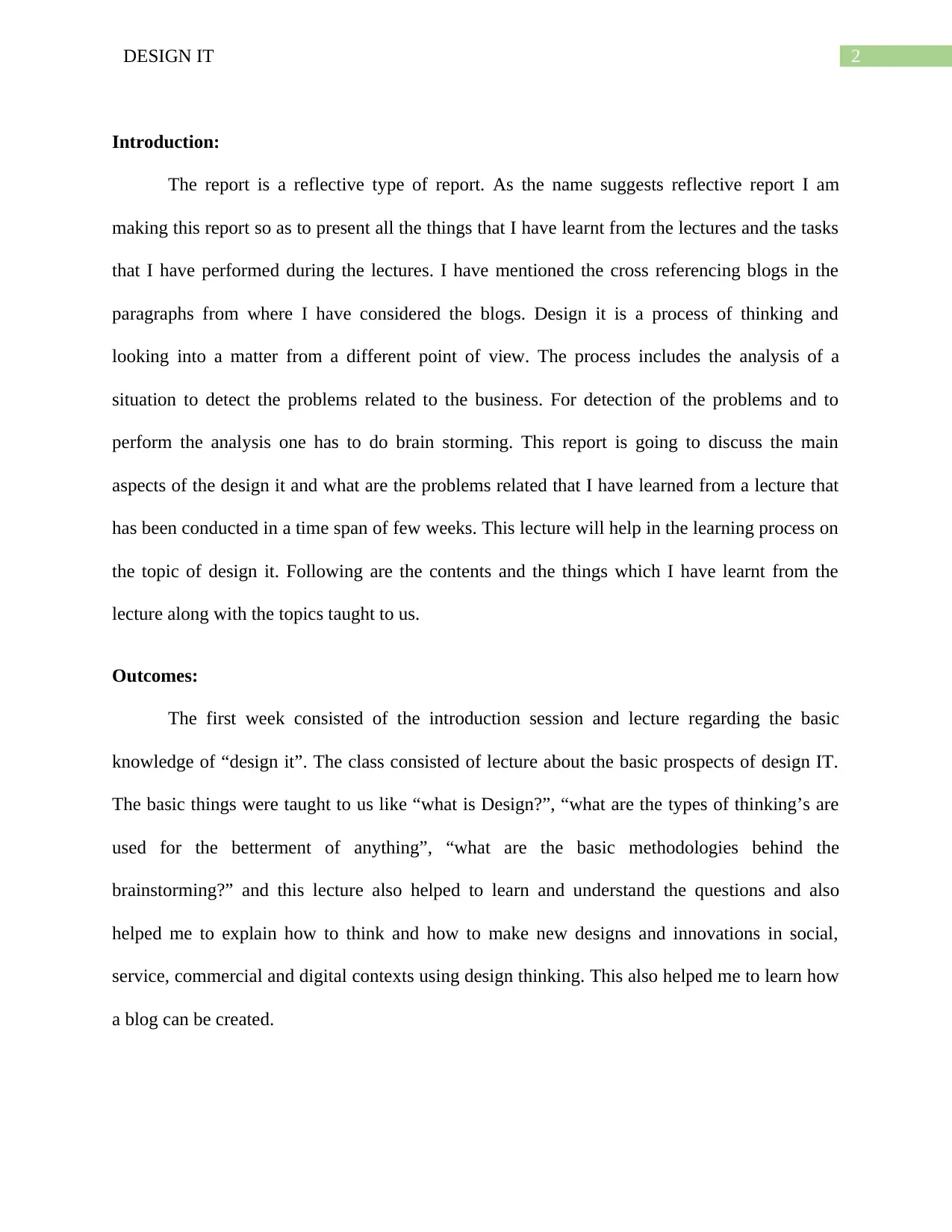
2DESIGN IT
Introduction:
The report is a reflective type of report. As the name suggests reflective report I am
making this report so as to present all the things that I have learnt from the lectures and the tasks
that I have performed during the lectures. I have mentioned the cross referencing blogs in the
paragraphs from where I have considered the blogs. Design it is a process of thinking and
looking into a matter from a different point of view. The process includes the analysis of a
situation to detect the problems related to the business. For detection of the problems and to
perform the analysis one has to do brain storming. This report is going to discuss the main
aspects of the design it and what are the problems related that I have learned from a lecture that
has been conducted in a time span of few weeks. This lecture will help in the learning process on
the topic of design it. Following are the contents and the things which I have learnt from the
lecture along with the topics taught to us.
Outcomes:
The first week consisted of the introduction session and lecture regarding the basic
knowledge of “design it”. The class consisted of lecture about the basic prospects of design IT.
The basic things were taught to us like “what is Design?”, “what are the types of thinking’s are
used for the betterment of anything”, “what are the basic methodologies behind the
brainstorming?” and this lecture also helped to learn and understand the questions and also
helped me to explain how to think and how to make new designs and innovations in social,
service, commercial and digital contexts using design thinking. This also helped me to learn how
a blog can be created.
Introduction:
The report is a reflective type of report. As the name suggests reflective report I am
making this report so as to present all the things that I have learnt from the lectures and the tasks
that I have performed during the lectures. I have mentioned the cross referencing blogs in the
paragraphs from where I have considered the blogs. Design it is a process of thinking and
looking into a matter from a different point of view. The process includes the analysis of a
situation to detect the problems related to the business. For detection of the problems and to
perform the analysis one has to do brain storming. This report is going to discuss the main
aspects of the design it and what are the problems related that I have learned from a lecture that
has been conducted in a time span of few weeks. This lecture will help in the learning process on
the topic of design it. Following are the contents and the things which I have learnt from the
lecture along with the topics taught to us.
Outcomes:
The first week consisted of the introduction session and lecture regarding the basic
knowledge of “design it”. The class consisted of lecture about the basic prospects of design IT.
The basic things were taught to us like “what is Design?”, “what are the types of thinking’s are
used for the betterment of anything”, “what are the basic methodologies behind the
brainstorming?” and this lecture also helped to learn and understand the questions and also
helped me to explain how to think and how to make new designs and innovations in social,
service, commercial and digital contexts using design thinking. This also helped me to learn how
a blog can be created.
⊘ This is a preview!⊘
Do you want full access?
Subscribe today to unlock all pages.

Trusted by 1+ million students worldwide
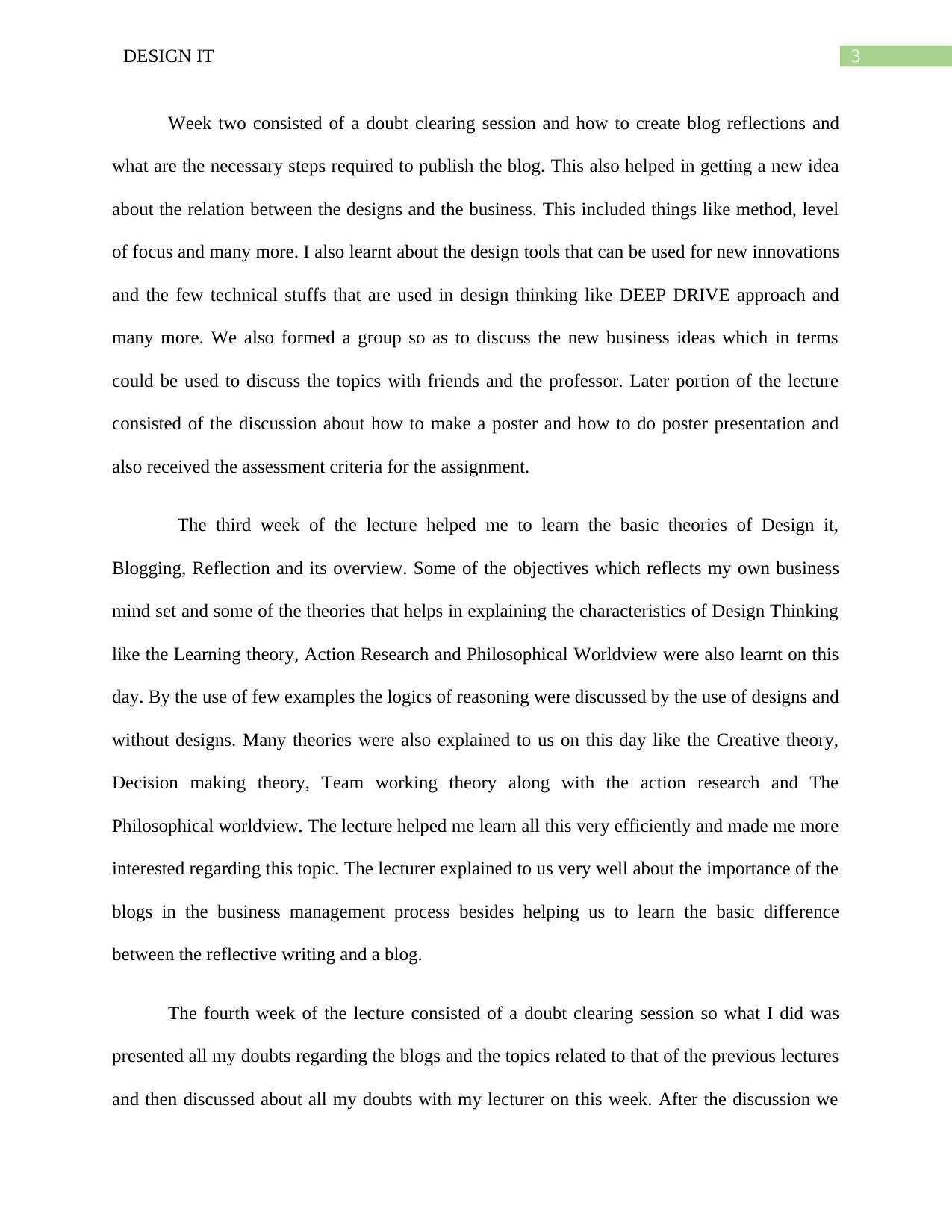
3DESIGN IT
Week two consisted of a doubt clearing session and how to create blog reflections and
what are the necessary steps required to publish the blog. This also helped in getting a new idea
about the relation between the designs and the business. This included things like method, level
of focus and many more. I also learnt about the design tools that can be used for new innovations
and the few technical stuffs that are used in design thinking like DEEP DRIVE approach and
many more. We also formed a group so as to discuss the new business ideas which in terms
could be used to discuss the topics with friends and the professor. Later portion of the lecture
consisted of the discussion about how to make a poster and how to do poster presentation and
also received the assessment criteria for the assignment.
The third week of the lecture helped me to learn the basic theories of Design it,
Blogging, Reflection and its overview. Some of the objectives which reflects my own business
mind set and some of the theories that helps in explaining the characteristics of Design Thinking
like the Learning theory, Action Research and Philosophical Worldview were also learnt on this
day. By the use of few examples the logics of reasoning were discussed by the use of designs and
without designs. Many theories were also explained to us on this day like the Creative theory,
Decision making theory, Team working theory along with the action research and The
Philosophical worldview. The lecture helped me learn all this very efficiently and made me more
interested regarding this topic. The lecturer explained to us very well about the importance of the
blogs in the business management process besides helping us to learn the basic difference
between the reflective writing and a blog.
The fourth week of the lecture consisted of a doubt clearing session so what I did was
presented all my doubts regarding the blogs and the topics related to that of the previous lectures
and then discussed about all my doubts with my lecturer on this week. After the discussion we
Week two consisted of a doubt clearing session and how to create blog reflections and
what are the necessary steps required to publish the blog. This also helped in getting a new idea
about the relation between the designs and the business. This included things like method, level
of focus and many more. I also learnt about the design tools that can be used for new innovations
and the few technical stuffs that are used in design thinking like DEEP DRIVE approach and
many more. We also formed a group so as to discuss the new business ideas which in terms
could be used to discuss the topics with friends and the professor. Later portion of the lecture
consisted of the discussion about how to make a poster and how to do poster presentation and
also received the assessment criteria for the assignment.
The third week of the lecture helped me to learn the basic theories of Design it,
Blogging, Reflection and its overview. Some of the objectives which reflects my own business
mind set and some of the theories that helps in explaining the characteristics of Design Thinking
like the Learning theory, Action Research and Philosophical Worldview were also learnt on this
day. By the use of few examples the logics of reasoning were discussed by the use of designs and
without designs. Many theories were also explained to us on this day like the Creative theory,
Decision making theory, Team working theory along with the action research and The
Philosophical worldview. The lecture helped me learn all this very efficiently and made me more
interested regarding this topic. The lecturer explained to us very well about the importance of the
blogs in the business management process besides helping us to learn the basic difference
between the reflective writing and a blog.
The fourth week of the lecture consisted of a doubt clearing session so what I did was
presented all my doubts regarding the blogs and the topics related to that of the previous lectures
and then discussed about all my doubts with my lecturer on this week. After the discussion we
Paraphrase This Document
Need a fresh take? Get an instant paraphrase of this document with our AI Paraphraser
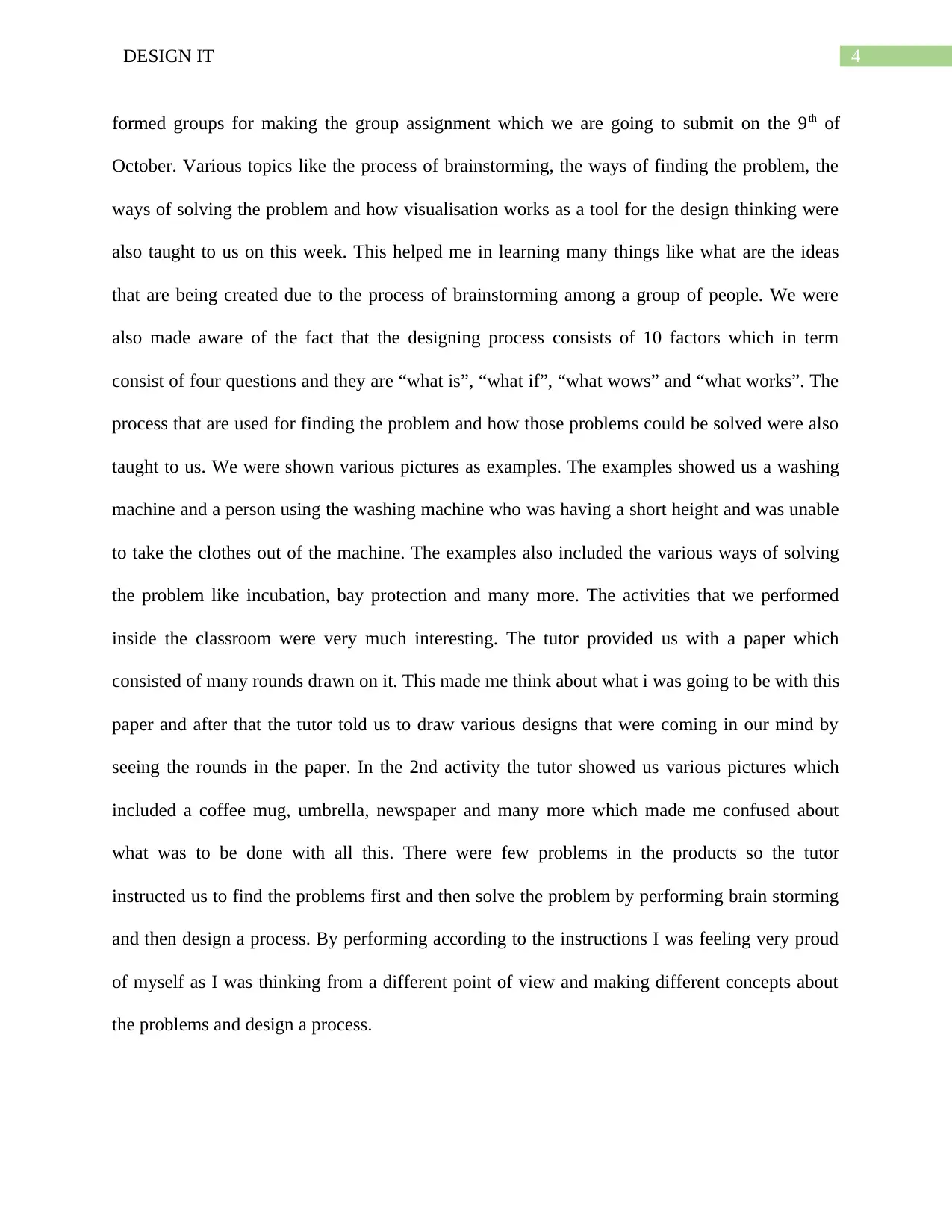
4DESIGN IT
formed groups for making the group assignment which we are going to submit on the 9th of
October. Various topics like the process of brainstorming, the ways of finding the problem, the
ways of solving the problem and how visualisation works as a tool for the design thinking were
also taught to us on this week. This helped me in learning many things like what are the ideas
that are being created due to the process of brainstorming among a group of people. We were
also made aware of the fact that the designing process consists of 10 factors which in term
consist of four questions and they are “what is”, “what if”, “what wows” and “what works”. The
process that are used for finding the problem and how those problems could be solved were also
taught to us. We were shown various pictures as examples. The examples showed us a washing
machine and a person using the washing machine who was having a short height and was unable
to take the clothes out of the machine. The examples also included the various ways of solving
the problem like incubation, bay protection and many more. The activities that we performed
inside the classroom were very much interesting. The tutor provided us with a paper which
consisted of many rounds drawn on it. This made me think about what i was going to be with this
paper and after that the tutor told us to draw various designs that were coming in our mind by
seeing the rounds in the paper. In the 2nd activity the tutor showed us various pictures which
included a coffee mug, umbrella, newspaper and many more which made me confused about
what was to be done with all this. There were few problems in the products so the tutor
instructed us to find the problems first and then solve the problem by performing brain storming
and then design a process. By performing according to the instructions I was feeling very proud
of myself as I was thinking from a different point of view and making different concepts about
the problems and design a process.
formed groups for making the group assignment which we are going to submit on the 9th of
October. Various topics like the process of brainstorming, the ways of finding the problem, the
ways of solving the problem and how visualisation works as a tool for the design thinking were
also taught to us on this week. This helped me in learning many things like what are the ideas
that are being created due to the process of brainstorming among a group of people. We were
also made aware of the fact that the designing process consists of 10 factors which in term
consist of four questions and they are “what is”, “what if”, “what wows” and “what works”. The
process that are used for finding the problem and how those problems could be solved were also
taught to us. We were shown various pictures as examples. The examples showed us a washing
machine and a person using the washing machine who was having a short height and was unable
to take the clothes out of the machine. The examples also included the various ways of solving
the problem like incubation, bay protection and many more. The activities that we performed
inside the classroom were very much interesting. The tutor provided us with a paper which
consisted of many rounds drawn on it. This made me think about what i was going to be with this
paper and after that the tutor told us to draw various designs that were coming in our mind by
seeing the rounds in the paper. In the 2nd activity the tutor showed us various pictures which
included a coffee mug, umbrella, newspaper and many more which made me confused about
what was to be done with all this. There were few problems in the products so the tutor
instructed us to find the problems first and then solve the problem by performing brain storming
and then design a process. By performing according to the instructions I was feeling very proud
of myself as I was thinking from a different point of view and making different concepts about
the problems and design a process.
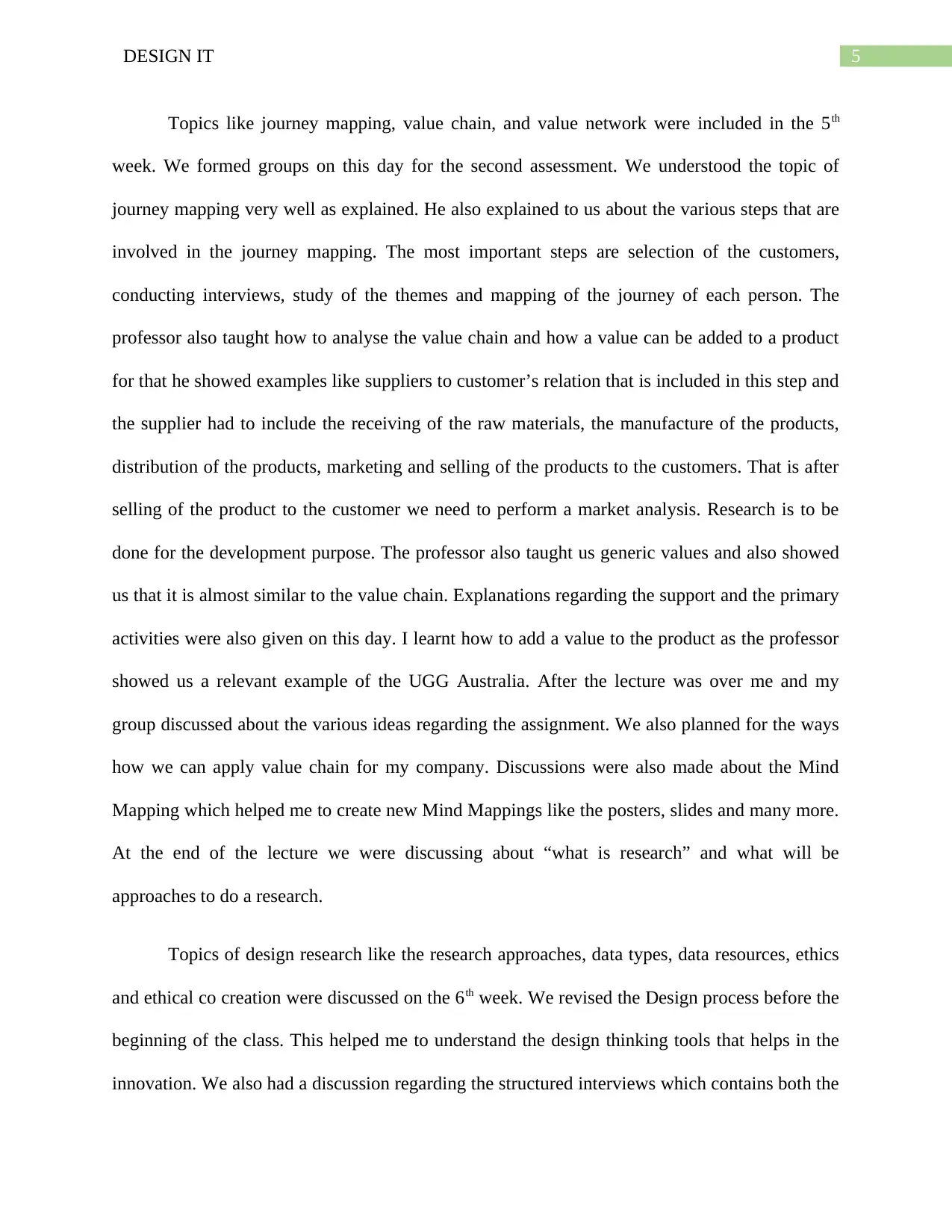
5DESIGN IT
Topics like journey mapping, value chain, and value network were included in the 5th
week. We formed groups on this day for the second assessment. We understood the topic of
journey mapping very well as explained. He also explained to us about the various steps that are
involved in the journey mapping. The most important steps are selection of the customers,
conducting interviews, study of the themes and mapping of the journey of each person. The
professor also taught how to analyse the value chain and how a value can be added to a product
for that he showed examples like suppliers to customer’s relation that is included in this step and
the supplier had to include the receiving of the raw materials, the manufacture of the products,
distribution of the products, marketing and selling of the products to the customers. That is after
selling of the product to the customer we need to perform a market analysis. Research is to be
done for the development purpose. The professor also taught us generic values and also showed
us that it is almost similar to the value chain. Explanations regarding the support and the primary
activities were also given on this day. I learnt how to add a value to the product as the professor
showed us a relevant example of the UGG Australia. After the lecture was over me and my
group discussed about the various ideas regarding the assignment. We also planned for the ways
how we can apply value chain for my company. Discussions were also made about the Mind
Mapping which helped me to create new Mind Mappings like the posters, slides and many more.
At the end of the lecture we were discussing about “what is research” and what will be
approaches to do a research.
Topics of design research like the research approaches, data types, data resources, ethics
and ethical co creation were discussed on the 6th week. We revised the Design process before the
beginning of the class. This helped me to understand the design thinking tools that helps in the
innovation. We also had a discussion regarding the structured interviews which contains both the
Topics like journey mapping, value chain, and value network were included in the 5th
week. We formed groups on this day for the second assessment. We understood the topic of
journey mapping very well as explained. He also explained to us about the various steps that are
involved in the journey mapping. The most important steps are selection of the customers,
conducting interviews, study of the themes and mapping of the journey of each person. The
professor also taught how to analyse the value chain and how a value can be added to a product
for that he showed examples like suppliers to customer’s relation that is included in this step and
the supplier had to include the receiving of the raw materials, the manufacture of the products,
distribution of the products, marketing and selling of the products to the customers. That is after
selling of the product to the customer we need to perform a market analysis. Research is to be
done for the development purpose. The professor also taught us generic values and also showed
us that it is almost similar to the value chain. Explanations regarding the support and the primary
activities were also given on this day. I learnt how to add a value to the product as the professor
showed us a relevant example of the UGG Australia. After the lecture was over me and my
group discussed about the various ideas regarding the assignment. We also planned for the ways
how we can apply value chain for my company. Discussions were also made about the Mind
Mapping which helped me to create new Mind Mappings like the posters, slides and many more.
At the end of the lecture we were discussing about “what is research” and what will be
approaches to do a research.
Topics of design research like the research approaches, data types, data resources, ethics
and ethical co creation were discussed on the 6th week. We revised the Design process before the
beginning of the class. This helped me to understand the design thinking tools that helps in the
innovation. We also had a discussion regarding the structured interviews which contains both the
⊘ This is a preview!⊘
Do you want full access?
Subscribe today to unlock all pages.

Trusted by 1+ million students worldwide
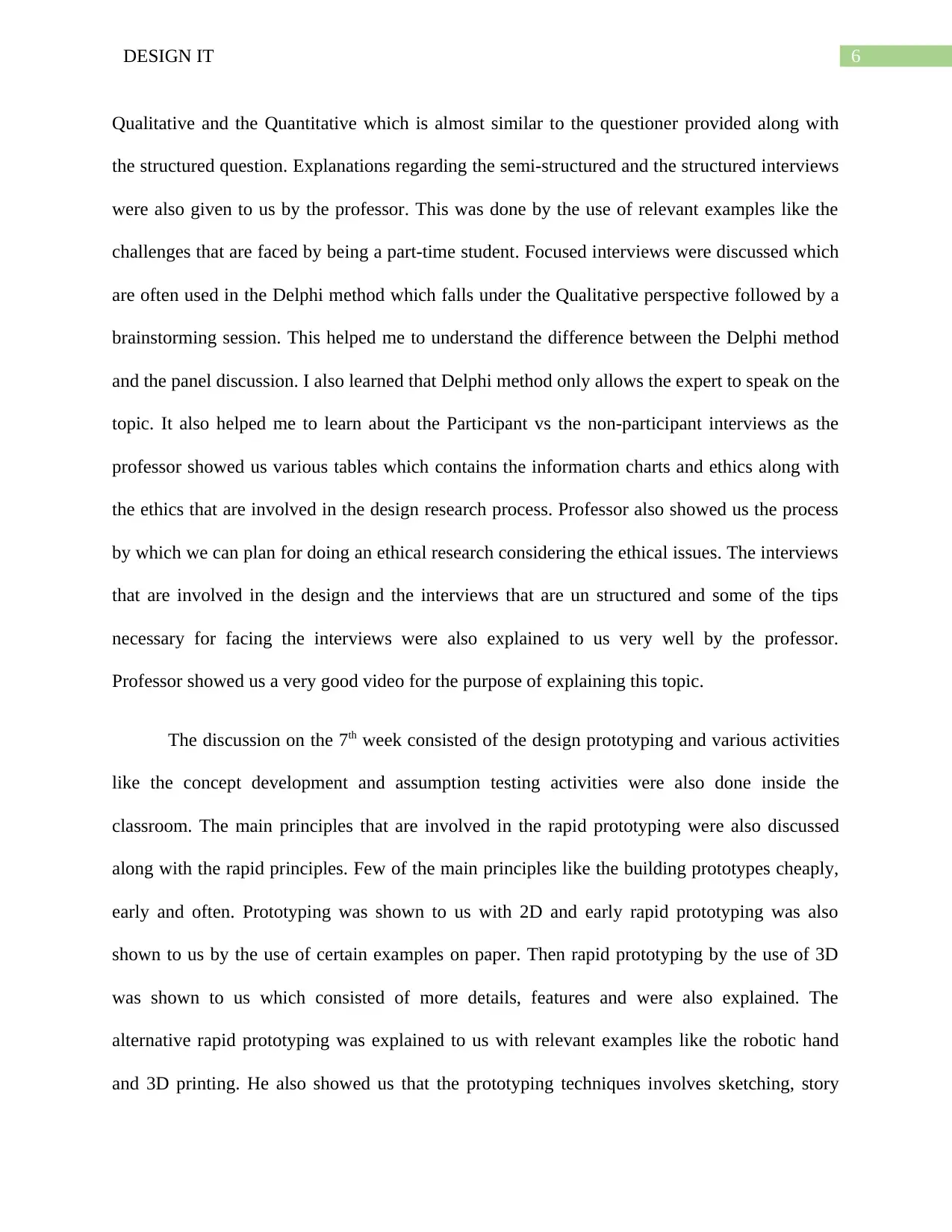
6DESIGN IT
Qualitative and the Quantitative which is almost similar to the questioner provided along with
the structured question. Explanations regarding the semi-structured and the structured interviews
were also given to us by the professor. This was done by the use of relevant examples like the
challenges that are faced by being a part-time student. Focused interviews were discussed which
are often used in the Delphi method which falls under the Qualitative perspective followed by a
brainstorming session. This helped me to understand the difference between the Delphi method
and the panel discussion. I also learned that Delphi method only allows the expert to speak on the
topic. It also helped me to learn about the Participant vs the non-participant interviews as the
professor showed us various tables which contains the information charts and ethics along with
the ethics that are involved in the design research process. Professor also showed us the process
by which we can plan for doing an ethical research considering the ethical issues. The interviews
that are involved in the design and the interviews that are un structured and some of the tips
necessary for facing the interviews were also explained to us very well by the professor.
Professor showed us a very good video for the purpose of explaining this topic.
The discussion on the 7th week consisted of the design prototyping and various activities
like the concept development and assumption testing activities were also done inside the
classroom. The main principles that are involved in the rapid prototyping were also discussed
along with the rapid principles. Few of the main principles like the building prototypes cheaply,
early and often. Prototyping was shown to us with 2D and early rapid prototyping was also
shown to us by the use of certain examples on paper. Then rapid prototyping by the use of 3D
was shown to us which consisted of more details, features and were also explained. The
alternative rapid prototyping was explained to us with relevant examples like the robotic hand
and 3D printing. He also showed us that the prototyping techniques involves sketching, story
Qualitative and the Quantitative which is almost similar to the questioner provided along with
the structured question. Explanations regarding the semi-structured and the structured interviews
were also given to us by the professor. This was done by the use of relevant examples like the
challenges that are faced by being a part-time student. Focused interviews were discussed which
are often used in the Delphi method which falls under the Qualitative perspective followed by a
brainstorming session. This helped me to understand the difference between the Delphi method
and the panel discussion. I also learned that Delphi method only allows the expert to speak on the
topic. It also helped me to learn about the Participant vs the non-participant interviews as the
professor showed us various tables which contains the information charts and ethics along with
the ethics that are involved in the design research process. Professor also showed us the process
by which we can plan for doing an ethical research considering the ethical issues. The interviews
that are involved in the design and the interviews that are un structured and some of the tips
necessary for facing the interviews were also explained to us very well by the professor.
Professor showed us a very good video for the purpose of explaining this topic.
The discussion on the 7th week consisted of the design prototyping and various activities
like the concept development and assumption testing activities were also done inside the
classroom. The main principles that are involved in the rapid prototyping were also discussed
along with the rapid principles. Few of the main principles like the building prototypes cheaply,
early and often. Prototyping was shown to us with 2D and early rapid prototyping was also
shown to us by the use of certain examples on paper. Then rapid prototyping by the use of 3D
was shown to us which consisted of more details, features and were also explained. The
alternative rapid prototyping was explained to us with relevant examples like the robotic hand
and 3D printing. He also showed us that the prototyping techniques involves sketching, story
Paraphrase This Document
Need a fresh take? Get an instant paraphrase of this document with our AI Paraphraser
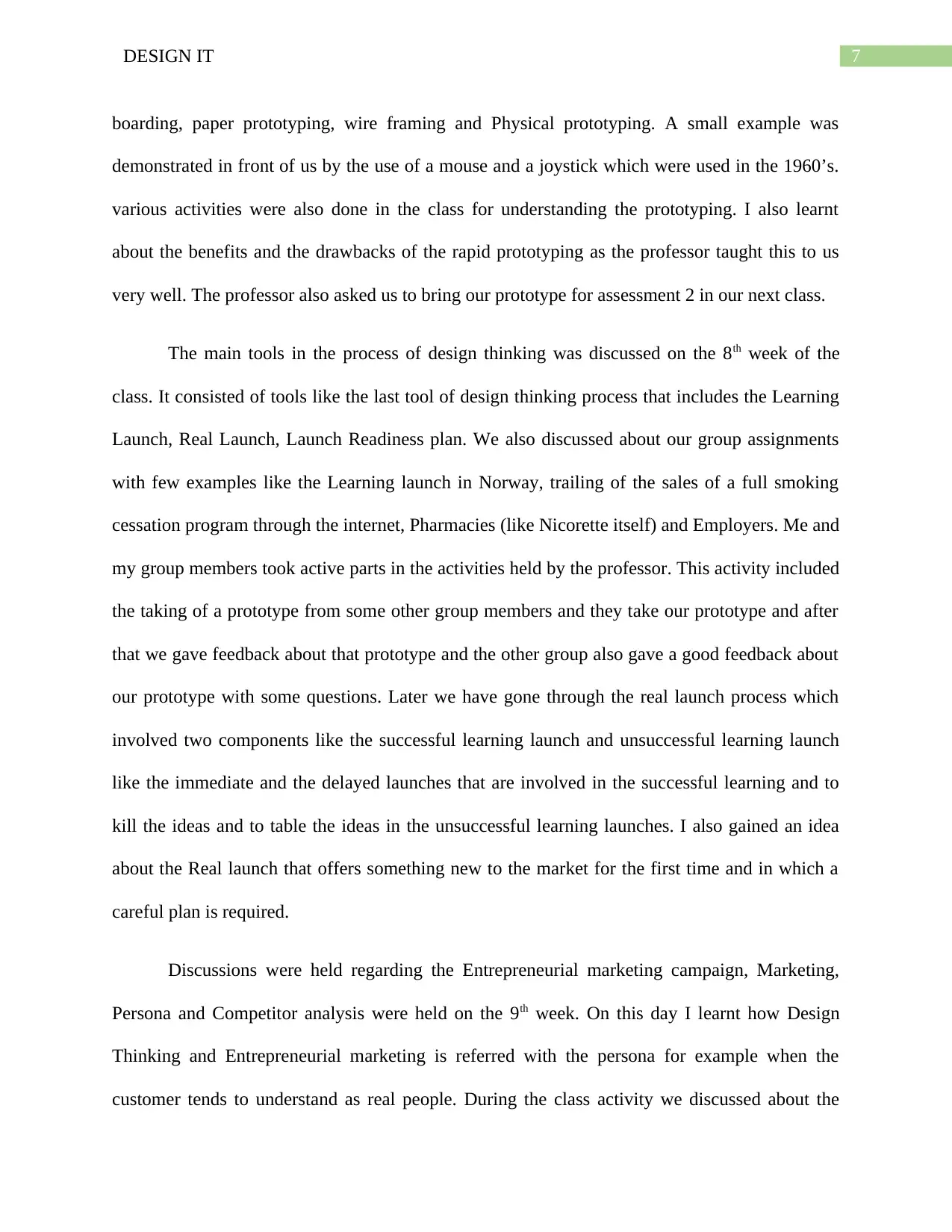
7DESIGN IT
boarding, paper prototyping, wire framing and Physical prototyping. A small example was
demonstrated in front of us by the use of a mouse and a joystick which were used in the 1960’s.
various activities were also done in the class for understanding the prototyping. I also learnt
about the benefits and the drawbacks of the rapid prototyping as the professor taught this to us
very well. The professor also asked us to bring our prototype for assessment 2 in our next class.
The main tools in the process of design thinking was discussed on the 8th week of the
class. It consisted of tools like the last tool of design thinking process that includes the Learning
Launch, Real Launch, Launch Readiness plan. We also discussed about our group assignments
with few examples like the Learning launch in Norway, trailing of the sales of a full smoking
cessation program through the internet, Pharmacies (like Nicorette itself) and Employers. Me and
my group members took active parts in the activities held by the professor. This activity included
the taking of a prototype from some other group members and they take our prototype and after
that we gave feedback about that prototype and the other group also gave a good feedback about
our prototype with some questions. Later we have gone through the real launch process which
involved two components like the successful learning launch and unsuccessful learning launch
like the immediate and the delayed launches that are involved in the successful learning and to
kill the ideas and to table the ideas in the unsuccessful learning launches. I also gained an idea
about the Real launch that offers something new to the market for the first time and in which a
careful plan is required.
Discussions were held regarding the Entrepreneurial marketing campaign, Marketing,
Persona and Competitor analysis were held on the 9th week. On this day I learnt how Design
Thinking and Entrepreneurial marketing is referred with the persona for example when the
customer tends to understand as real people. During the class activity we discussed about the
boarding, paper prototyping, wire framing and Physical prototyping. A small example was
demonstrated in front of us by the use of a mouse and a joystick which were used in the 1960’s.
various activities were also done in the class for understanding the prototyping. I also learnt
about the benefits and the drawbacks of the rapid prototyping as the professor taught this to us
very well. The professor also asked us to bring our prototype for assessment 2 in our next class.
The main tools in the process of design thinking was discussed on the 8th week of the
class. It consisted of tools like the last tool of design thinking process that includes the Learning
Launch, Real Launch, Launch Readiness plan. We also discussed about our group assignments
with few examples like the Learning launch in Norway, trailing of the sales of a full smoking
cessation program through the internet, Pharmacies (like Nicorette itself) and Employers. Me and
my group members took active parts in the activities held by the professor. This activity included
the taking of a prototype from some other group members and they take our prototype and after
that we gave feedback about that prototype and the other group also gave a good feedback about
our prototype with some questions. Later we have gone through the real launch process which
involved two components like the successful learning launch and unsuccessful learning launch
like the immediate and the delayed launches that are involved in the successful learning and to
kill the ideas and to table the ideas in the unsuccessful learning launches. I also gained an idea
about the Real launch that offers something new to the market for the first time and in which a
careful plan is required.
Discussions were held regarding the Entrepreneurial marketing campaign, Marketing,
Persona and Competitor analysis were held on the 9th week. On this day I learnt how Design
Thinking and Entrepreneurial marketing is referred with the persona for example when the
customer tends to understand as real people. During the class activity we discussed about the
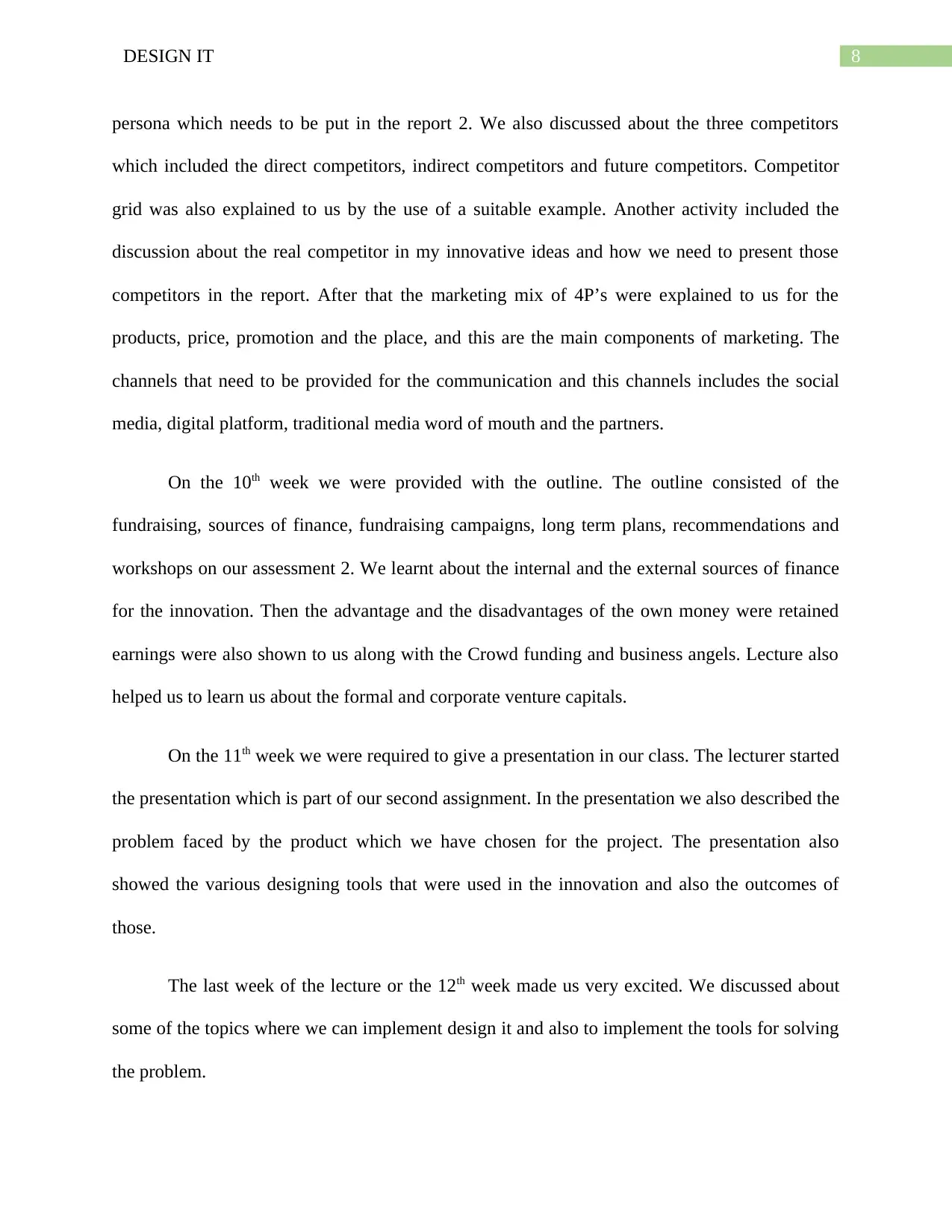
8DESIGN IT
persona which needs to be put in the report 2. We also discussed about the three competitors
which included the direct competitors, indirect competitors and future competitors. Competitor
grid was also explained to us by the use of a suitable example. Another activity included the
discussion about the real competitor in my innovative ideas and how we need to present those
competitors in the report. After that the marketing mix of 4P’s were explained to us for the
products, price, promotion and the place, and this are the main components of marketing. The
channels that need to be provided for the communication and this channels includes the social
media, digital platform, traditional media word of mouth and the partners.
On the 10th week we were provided with the outline. The outline consisted of the
fundraising, sources of finance, fundraising campaigns, long term plans, recommendations and
workshops on our assessment 2. We learnt about the internal and the external sources of finance
for the innovation. Then the advantage and the disadvantages of the own money were retained
earnings were also shown to us along with the Crowd funding and business angels. Lecture also
helped us to learn us about the formal and corporate venture capitals.
On the 11th week we were required to give a presentation in our class. The lecturer started
the presentation which is part of our second assignment. In the presentation we also described the
problem faced by the product which we have chosen for the project. The presentation also
showed the various designing tools that were used in the innovation and also the outcomes of
those.
The last week of the lecture or the 12th week made us very excited. We discussed about
some of the topics where we can implement design it and also to implement the tools for solving
the problem.
persona which needs to be put in the report 2. We also discussed about the three competitors
which included the direct competitors, indirect competitors and future competitors. Competitor
grid was also explained to us by the use of a suitable example. Another activity included the
discussion about the real competitor in my innovative ideas and how we need to present those
competitors in the report. After that the marketing mix of 4P’s were explained to us for the
products, price, promotion and the place, and this are the main components of marketing. The
channels that need to be provided for the communication and this channels includes the social
media, digital platform, traditional media word of mouth and the partners.
On the 10th week we were provided with the outline. The outline consisted of the
fundraising, sources of finance, fundraising campaigns, long term plans, recommendations and
workshops on our assessment 2. We learnt about the internal and the external sources of finance
for the innovation. Then the advantage and the disadvantages of the own money were retained
earnings were also shown to us along with the Crowd funding and business angels. Lecture also
helped us to learn us about the formal and corporate venture capitals.
On the 11th week we were required to give a presentation in our class. The lecturer started
the presentation which is part of our second assignment. In the presentation we also described the
problem faced by the product which we have chosen for the project. The presentation also
showed the various designing tools that were used in the innovation and also the outcomes of
those.
The last week of the lecture or the 12th week made us very excited. We discussed about
some of the topics where we can implement design it and also to implement the tools for solving
the problem.
⊘ This is a preview!⊘
Do you want full access?
Subscribe today to unlock all pages.

Trusted by 1+ million students worldwide
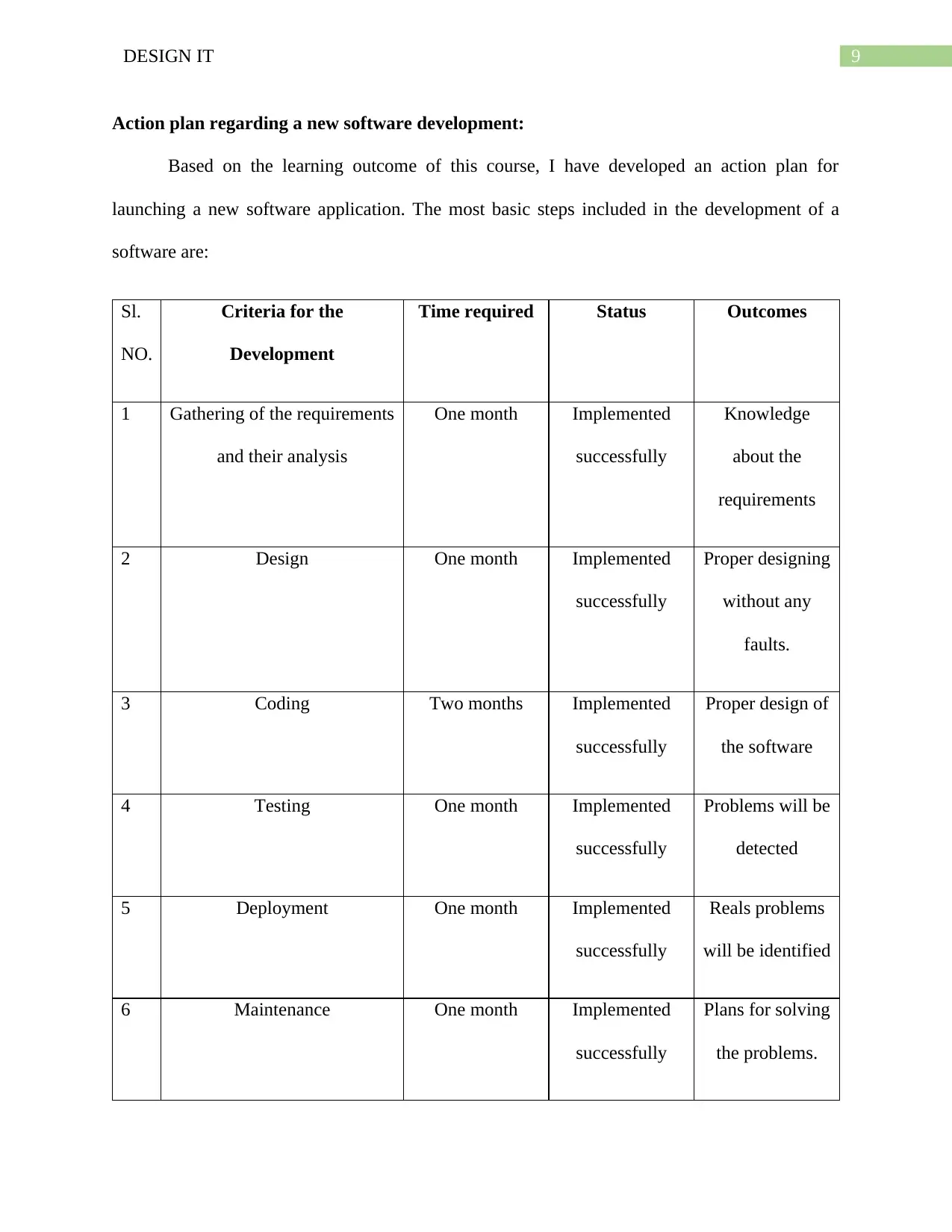
9DESIGN IT
Action plan regarding a new software development:
Based on the learning outcome of this course, I have developed an action plan for
launching a new software application. The most basic steps included in the development of a
software are:
Sl.
NO.
Criteria for the
Development
Time required Status Outcomes
1 Gathering of the requirements
and their analysis
One month Implemented
successfully
Knowledge
about the
requirements
2 Design One month Implemented
successfully
Proper designing
without any
faults.
3 Coding Two months Implemented
successfully
Proper design of
the software
4 Testing One month Implemented
successfully
Problems will be
detected
5 Deployment One month Implemented
successfully
Reals problems
will be identified
6 Maintenance One month Implemented
successfully
Plans for solving
the problems.
Action plan regarding a new software development:
Based on the learning outcome of this course, I have developed an action plan for
launching a new software application. The most basic steps included in the development of a
software are:
Sl.
NO.
Criteria for the
Development
Time required Status Outcomes
1 Gathering of the requirements
and their analysis
One month Implemented
successfully
Knowledge
about the
requirements
2 Design One month Implemented
successfully
Proper designing
without any
faults.
3 Coding Two months Implemented
successfully
Proper design of
the software
4 Testing One month Implemented
successfully
Problems will be
detected
5 Deployment One month Implemented
successfully
Reals problems
will be identified
6 Maintenance One month Implemented
successfully
Plans for solving
the problems.
Paraphrase This Document
Need a fresh take? Get an instant paraphrase of this document with our AI Paraphraser
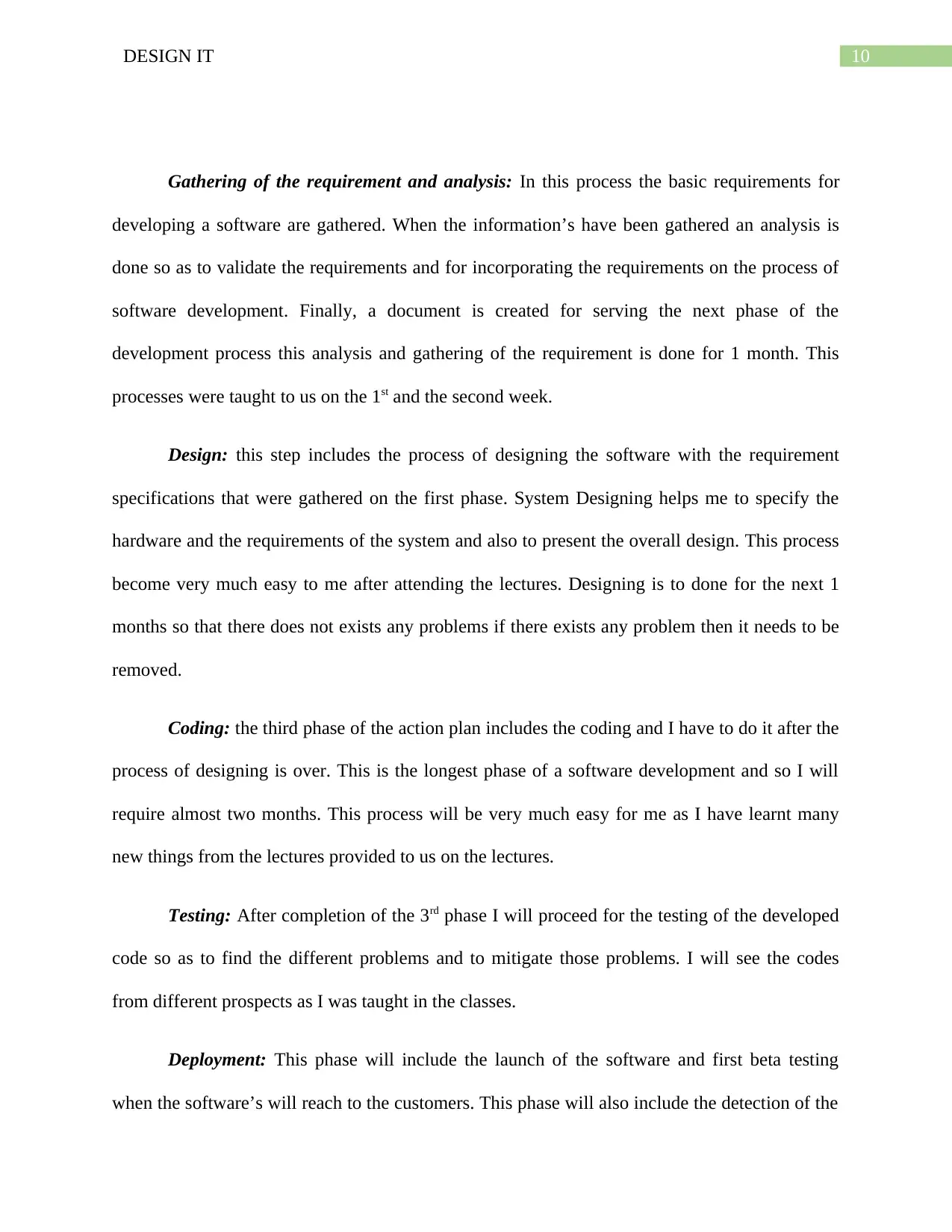
10DESIGN IT
Gathering of the requirement and analysis: In this process the basic requirements for
developing a software are gathered. When the information’s have been gathered an analysis is
done so as to validate the requirements and for incorporating the requirements on the process of
software development. Finally, a document is created for serving the next phase of the
development process this analysis and gathering of the requirement is done for 1 month. This
processes were taught to us on the 1st and the second week.
Design: this step includes the process of designing the software with the requirement
specifications that were gathered on the first phase. System Designing helps me to specify the
hardware and the requirements of the system and also to present the overall design. This process
become very much easy to me after attending the lectures. Designing is to done for the next 1
months so that there does not exists any problems if there exists any problem then it needs to be
removed.
Coding: the third phase of the action plan includes the coding and I have to do it after the
process of designing is over. This is the longest phase of a software development and so I will
require almost two months. This process will be very much easy for me as I have learnt many
new things from the lectures provided to us on the lectures.
Testing: After completion of the 3rd phase I will proceed for the testing of the developed
code so as to find the different problems and to mitigate those problems. I will see the codes
from different prospects as I was taught in the classes.
Deployment: This phase will include the launch of the software and first beta testing
when the software’s will reach to the customers. This phase will also include the detection of the
Gathering of the requirement and analysis: In this process the basic requirements for
developing a software are gathered. When the information’s have been gathered an analysis is
done so as to validate the requirements and for incorporating the requirements on the process of
software development. Finally, a document is created for serving the next phase of the
development process this analysis and gathering of the requirement is done for 1 month. This
processes were taught to us on the 1st and the second week.
Design: this step includes the process of designing the software with the requirement
specifications that were gathered on the first phase. System Designing helps me to specify the
hardware and the requirements of the system and also to present the overall design. This process
become very much easy to me after attending the lectures. Designing is to done for the next 1
months so that there does not exists any problems if there exists any problem then it needs to be
removed.
Coding: the third phase of the action plan includes the coding and I have to do it after the
process of designing is over. This is the longest phase of a software development and so I will
require almost two months. This process will be very much easy for me as I have learnt many
new things from the lectures provided to us on the lectures.
Testing: After completion of the 3rd phase I will proceed for the testing of the developed
code so as to find the different problems and to mitigate those problems. I will see the codes
from different prospects as I was taught in the classes.
Deployment: This phase will include the launch of the software and first beta testing
when the software’s will reach to the customers. This phase will also include the detection of the
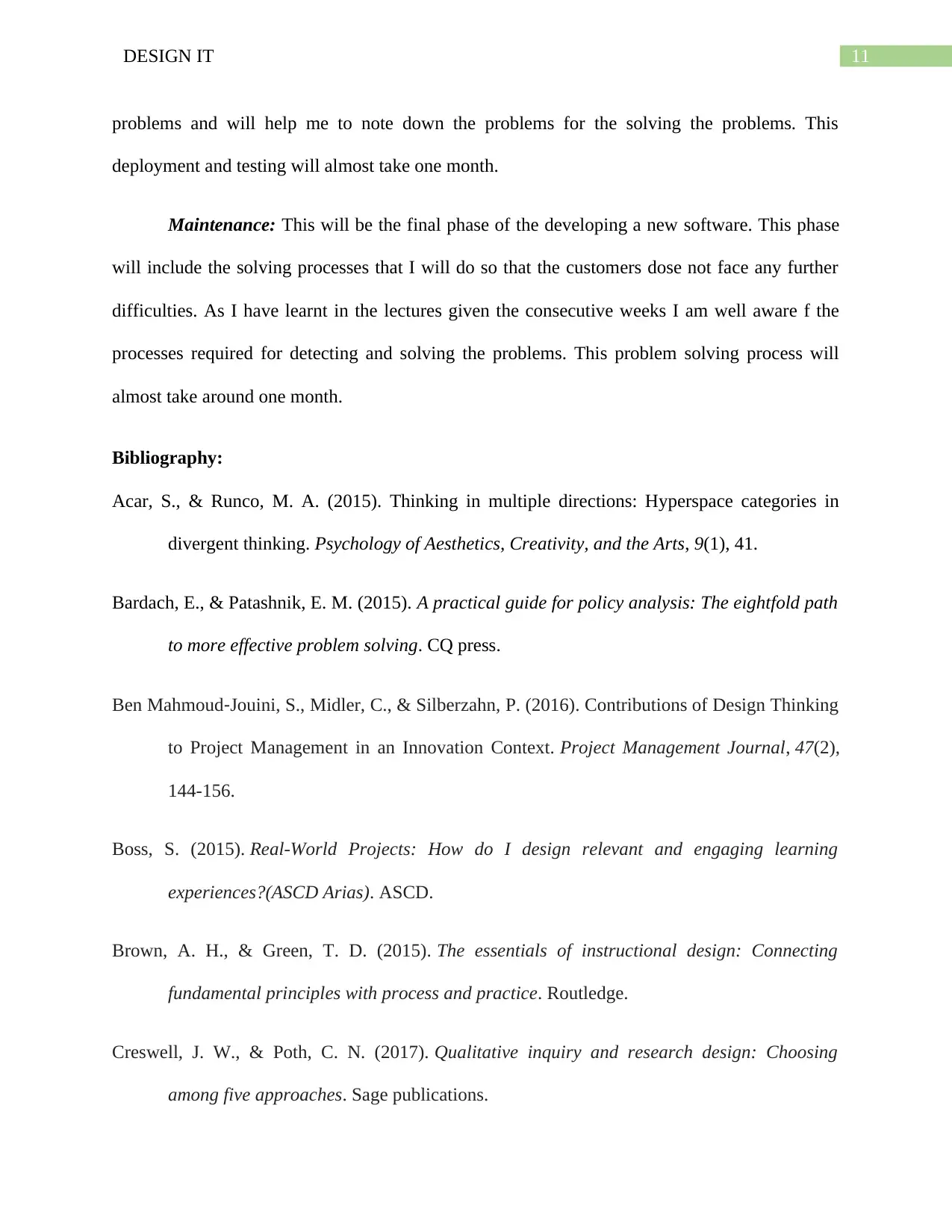
11DESIGN IT
problems and will help me to note down the problems for the solving the problems. This
deployment and testing will almost take one month.
Maintenance: This will be the final phase of the developing a new software. This phase
will include the solving processes that I will do so that the customers dose not face any further
difficulties. As I have learnt in the lectures given the consecutive weeks I am well aware f the
processes required for detecting and solving the problems. This problem solving process will
almost take around one month.
Bibliography:
Acar, S., & Runco, M. A. (2015). Thinking in multiple directions: Hyperspace categories in
divergent thinking. Psychology of Aesthetics, Creativity, and the Arts, 9(1), 41.
Bardach, E., & Patashnik, E. M. (2015). A practical guide for policy analysis: The eightfold path
to more effective problem solving. CQ press.
Ben Mahmoud‐Jouini, S., Midler, C., & Silberzahn, P. (2016). Contributions of Design Thinking
to Project Management in an Innovation Context. Project Management Journal, 47(2),
144-156.
Boss, S. (2015). Real-World Projects: How do I design relevant and engaging learning
experiences?(ASCD Arias). ASCD.
Brown, A. H., & Green, T. D. (2015). The essentials of instructional design: Connecting
fundamental principles with process and practice. Routledge.
Creswell, J. W., & Poth, C. N. (2017). Qualitative inquiry and research design: Choosing
among five approaches. Sage publications.
problems and will help me to note down the problems for the solving the problems. This
deployment and testing will almost take one month.
Maintenance: This will be the final phase of the developing a new software. This phase
will include the solving processes that I will do so that the customers dose not face any further
difficulties. As I have learnt in the lectures given the consecutive weeks I am well aware f the
processes required for detecting and solving the problems. This problem solving process will
almost take around one month.
Bibliography:
Acar, S., & Runco, M. A. (2015). Thinking in multiple directions: Hyperspace categories in
divergent thinking. Psychology of Aesthetics, Creativity, and the Arts, 9(1), 41.
Bardach, E., & Patashnik, E. M. (2015). A practical guide for policy analysis: The eightfold path
to more effective problem solving. CQ press.
Ben Mahmoud‐Jouini, S., Midler, C., & Silberzahn, P. (2016). Contributions of Design Thinking
to Project Management in an Innovation Context. Project Management Journal, 47(2),
144-156.
Boss, S. (2015). Real-World Projects: How do I design relevant and engaging learning
experiences?(ASCD Arias). ASCD.
Brown, A. H., & Green, T. D. (2015). The essentials of instructional design: Connecting
fundamental principles with process and practice. Routledge.
Creswell, J. W., & Poth, C. N. (2017). Qualitative inquiry and research design: Choosing
among five approaches. Sage publications.
⊘ This is a preview!⊘
Do you want full access?
Subscribe today to unlock all pages.

Trusted by 1+ million students worldwide
1 out of 14
Related Documents
Your All-in-One AI-Powered Toolkit for Academic Success.
+13062052269
info@desklib.com
Available 24*7 on WhatsApp / Email
![[object Object]](/_next/static/media/star-bottom.7253800d.svg)
Unlock your academic potential
Copyright © 2020–2025 A2Z Services. All Rights Reserved. Developed and managed by ZUCOL.




